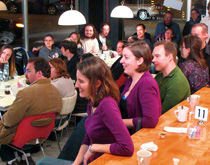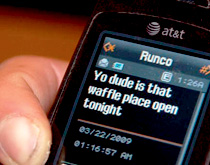
The tuxedo shop, nestled in a neighborhood retail hub a few miles from campus, had been abandoned. The carpet had been removed, leaving behind a coat of dried glue that clung to the tile floor. The walls were a forgettable dirty white, while black and gold changing rooms stood glaring from the corner. Everything in the shop seemed to be thrown together with a random combination of screws and nails. The space was rough, but as 12 Carnegie Mellon students walked through its doors on the first day of class, they saw it for what it was: a blank canvas.
It was not a typical blank canvas, but then this was not a typical art class. The tuxedo shop had been chosen as the location for the next in a series of Storefront Projects, born from the Contextual Practice area of the School of Art. The projects aim to catalyze a relationship between art and the place where it exists. What the class created was a cozy niche for the late-night crowd where they could order homemade waffles and speak their minds—on camera—while they dined.
The classmates—under the direction of Jon Rubin, an assistant professor of art—head to Construction Junction, where they purchased materials to piece together some furniture and counters. They painstakingly stripped the glue off the floors and painted the walls yellow. When it became time to brainstorm a name for the diner, passers-by even chimed in. "Please name it 'The Awful Waffle!'" read one Post-It note stuck anonymously on the front window.

The classmates opened the Waffle Shop last fall. Night-owl diners were filmed chatting about what was on their minds while gobbling up waffles during the weekend hours of 11 p.m. to 3 a.m. The concept continued to thrive, and each week the footage was edited into a short episode that aired 24/7 in a loop on a TV in the East Liberty storefront window. The episodes are also online (waffleshop.org).
With a new semester, and a new group of students, the space is in a constant state of flux. Last spring, the yellow walls became blue and the reality show morphed into a talk show hosted either by a student or, occasionally, someone from the neighborhood. The menu expanded, too, including the popular Savory Waffle, in which bacon, eggs, and cheese are folded into the batter.
But the main premise has remained constant, says Abbey McClain (HS'09), one of the original students: "Other than getting people talking while eating cheap waffles, it gets people to think about art in different ways."
—Kate Dunfee



